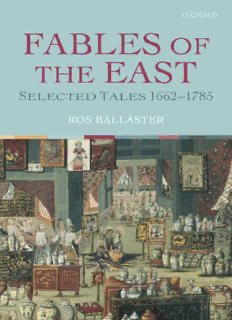
Fables of the East: Selected Tales 1662-1785 PDF
Preview Fables of the East: Selected Tales 1662-1785
ables of the ast F E ?M This page intentionally left blank ables of F the ast E ?M?M?M "K"K"K Selected Tales 1662–1785 Editedby Ros Ballaster 1 1 GreatClarendonStreet,Oxfordox26dp OxfordUniversityPressisadepartmentoftheUniversityofOxford. ItfurtherstheUniversity’sobjectiveofexcellenceinresearch,scholarship, andeducationbypublishingworldwidein Oxford NewYork Auckland CapeTown DaresSalaam HongKong Karachi KualaLumpur Madrid Melbourne MexicoCity Nairobi NewDelhi Shanghai Taipei Toronto Withofficesin Argentina Austria Brazil Chile CzechRepublic France Greece Guatemala Hungary Italy Japan Poland Portugal Singapore SouthKorea Switzerland Thailand Turkey Ukraine Vietnam OxfordisaregisteredtrademarkofOxfordUniversityPress intheUKandincertainothercountries PublishedintheUnitedStates byOxfordUniversityPressInc.,NewYork #RosBallaster2005 Themoralrightsoftheauthorhavebeenasserted DatabaserightOxfordUniversityPress(maker) Firstpublished2005 Allrightsreserved.Nopartofthispublicationmaybereproduced, storedinaretrievalsystem,ortransmitted,inanyformorbyanymeans, withoutthepriorpermissioninwritingofOxfordUniversityPress, orasexpresslypermittedbylaw,orundertermsagreedwiththeappropriate reprographicsrightsorganization.Enquiriesconcerningreproduction outsidethescopeoftheaboveshouldbesenttotheRightsDepartment, OxfordUniversityPress,attheaddressabove Youmustnotcirculatethisbookinanyotherbindingorcover andyoumustimposethesameconditiononanyacquirer BritishLibraryCataloguinginPublicationData Dataavailable LibraryofCongressCataloginginPublicationData FablesoftheEast:selectedtales,1662–1785/editedbyRosBallaster. p.cm. Includesbibliographicalreferences. ISBN0–19–926734–0(acid-freepaper)—ISBN0–19–926735–9(pbk.:acid-freepaper) 1. Fables,Oriental. 2. Fables. I. Ballaster,Rosalind. PN981.F332005 398.20095—dc22 2005020146 TypesetbyNewgenImagingSystems(P)Ltd.,Chennai,India PrintedinGreatBritain onacid-freepaperby BiddlesLtd.,King’sLynn,Norfolk ISBN0–19–926734–0(Hbk.) 978–0–19–926734–7(Hbk.) ISBN0–19–926735–9(Pbk.) 978–0–19–926735–4(Pbk.) 1 3 5 7 9 10 8 6 4 2 ontents C ?M Textual Note vii Introduction 1 1. The Framed Sequence 13 From The Arabian Nights Entertainments, ‘translated’ by Antoine Galland (1704–1715) 15 ‘The Fable of the Mouse, that was Changed into a Little Girl’ from The Fables of Pilpay, translated by Joseph Harris (1699) 43 ‘The History of Commladeve’ from Tales, from the Inatulla of Delhi, translated by Alexander Dow (1768) 49 ‘The Adventures of Urad’ from James Ridley, Tales of the Genii (1764) 71 2. The Pseudo-Oriental Tale 101 ‘The History of the Christian Eunuch’ from Eliza Haywood, Philidore and Placentia (1727) 103 Joseph Addison, Spectator, no. 512, 17 October 1712 120 Horace Walpole, ‘Mi Li. A Chinese Fairy Tale’ from Hieroglyphic Tales (1785) 126 v Contents 3. Travels and History 139 ‘A Voyage to Kachemire, the Paradise of Indostan’ from Franc¸ois Bernier, A Continuation of the Memoires of Monsieur Bernier, translated by Henry Oldenburg (1672) 141 From The General History of the Mogol Empire, compiled by Franc¸ois Catrou from the memoirs of Niccolo Manucci (1709) 175 From Lady Mary Wortley Montagu, Letters of the Right Honourable Lady M——y W——y M——e (1763) 191 4. Letter Fictions 205 From Giovanni Paolo Marana, The Eight Volumes of Letters Writ by a Turkish Spy, translated by William Bradshaw (1687–1694) 207 From Charles Secondat de Montesquieu, Persian Letters, translated by Charles Ozell (1722) 239 From Oliver Goldsmith, The Citizen of the World (1762) 258 Glossary 269 vi extual ote T N ?M Copy-texts are from first editions where possible. Otherwise, I have usedlatereditionsascloseaspossibletothefirst.Eachtextisprefaced by an introduction giving the author, date of first publication, and edition used, with relevant context, information about the text and its author and/or translator, and explanation of its significance. The editor’s notes concentrate on explaining references to contemporary historyandintertextualconnectionswithotherwritingsaboutoriental cultures. All texts have been corrected to use speech marks (where often there are none in the original). I have not modernized spelling and punctuation except where it is needed for sense, and usually on the authority of a later edition. Otherwise, I have made no substantive changes to the original texts and hence individual emendations have not been recorded. Since the critical work that accompanies this anthology, Fabulous Orients: Fictions of the East in England 1662–1785 (Oxford: Oxford University Press, 2005), provides a full bibliography, I have simply given full references to all works cited in introductions or footnotes. Readersshouldconsulttheglossaryatthebackwhichoffersexplana- tions of oriental terms, general and geographical. vii This page intentionally left blank ntroduction I ?M The trope of the Orient in eighteenth-century England is ‘back- wardness’. To travel to oriental territories, to consume oriental nar- rative, is to travel ‘backward’ in time (to retrace ancient history), in space(fromthe‘new’tothe‘old’world),andinidentity(fromcontract and civility to despotism). Accordingly, the kind of story associated with the Orient is the most elementary and ancient form: the fable. Thus, James Beattie commences his 1780 essay, ‘On Fable and Romance’, with ‘General remarks on Ancient and Oriental Prose Fable’ as though the two terms were equivalent: itmaybepropertoobserve,thattheOrientalnationshavelongbeenfamous forfabulousnarrative.TheindolencepeculiartothegenialclimatesofAsia, andtheluxuriouslifewhichthekingsandothergreatmen,ofthosecountries, leadintheirseraglios,havemadethemseekforthissortofamusement,and setahighvalueuponit.WhenanEasternprincehappenstobeidle,ashe commonlyis,andatalossforexpedientstokillthetime,hecommandshis Grand Visir, or his favourite, to tell him stories. Being ignorant, and con- sequently credulous; having no passion for moral improvement, and little knowlegeofnature;hedoesnotdesire,thattheyshouldbeprobable,orofan instructivetendency:itisenoughiftheybeastonishing.Andhenceitis,no doubt,thatthoseorientaltalesaresoextravagant.Everythingiscarriedonby inchantmentandprodigy;byfairies,genii,anddemons,andwoodenhorses, which,onturningapeg,flythroughtheairwithinconceivableswiftness.1 BeattiegoesontoidentifyAntoineGalland’searlyeighteenth-century ‘translation’, known in England as The Arabian Nights Entertain- ments, as the most familiar example of oriental fable, and defends it, despite its incredibility, on the grounds that ‘It conveys a pretty 1 JamesBeattie,‘OnFableandRomance’,inDissertations,MoralandCritical,inThe WorksofJamesBeattie,ed.RogerJ.Robinson(London:Routledge/Thoemmes,1996), 505–74,508–9. 1
Description: